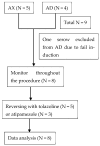Comparison of the Anesthetic Effects of Alfaxalone Combined with Xylazine or Dexmedetomidine in Captive Formosa Serows (Capricornis swinhoei)
- PMID: 39943077
- PMCID: PMC11815742
- DOI: 10.3390/ani15030307
Comparison of the Anesthetic Effects of Alfaxalone Combined with Xylazine or Dexmedetomidine in Captive Formosa Serows (Capricornis swinhoei)
Abstract
Formosan serows are an endemic species in Taiwan. Alfaxalone, a γ-aminobutyric acidA agonist, induces or maintains anesthesia in various veterinary species with reported potential adverse effects of respiratory depression and tachycardia. α2-Adrenoceptor agonists exert sedative and muscle relaxation effects, along with substantial cardiovascular adverse effects. Here, we aimed to evaluate the anesthetic effects of alfaxalone combined with xylazine or dexmedetomidine (AX vs. AD, respectively) in Formosan serows. In this randomized, masked study, AX was administered to four serows, and AD was administered to five serows intramuscularly via blow dart. The time and score of induction and recovery were recorded. Post-intubation, isoflurane was administered for maintenance anesthesia. Heart rate (HR), respiratory rate (RR), peripheral saturation of oxygenation (SpO2), rectal temperature (RT), and end-tidal CO2 (EtCO2) were recorded every five to eight minutes. Atipamezole and tolazoline were administered to antagonize dexmedetomidine and xylazine post-procedure, respectively. Both combinations allowed smooth induction and recovery. The AD group exhibited significantly lower HR and SpO2 and significantly higher RT and EtCO2 than the AX group (both p < 0.01). The AD-treated serows exhibited notable muscle rigidity after induction and significant hypoventilation and hypoxemia during the procedure. Although alfaxalone combined with dexmedetomidine or xylazine can produce satisfactory induction and recovery in Formosa serows, notable hypoxemia and hypoventilation are induced by the alfaxalone-dexmedetomidine combination compared to the alfaxalone-xylazine combination.
Keywords: Formosan serow (Capricornis swinhoei); alfaxalone; anesthesia; hypoventilation; hypoxemia.
Conflict of interest statement
The authors declare no conflicts of interest.
Figures









Similar articles
-
Comparison of xylazine-ketamine and dexmedetomidine-ketamine anesthesia in captive Formosan serows (Capricornis swinhoei).J Zoo Wildl Med. 2014 Dec;45(4):787-91. doi: 10.1638/2013-0291.1. J Zoo Wildl Med. 2014. PMID: 25632664 Clinical Trial.
-
Retrospective Comparison of the Anesthetic Effects of Tiletamine-Zolazepam with Dexmedetomidine and Ketamine with Dexmedetomidine in Captive Formosan Serow (Capricornis swinhoei).Animals (Basel). 2024 May 8;14(10):1413. doi: 10.3390/ani14101413. Animals (Basel). 2024. PMID: 38791631 Free PMC article.
-
Comparison of anesthetic effects of xylazine combined with alfaxalone or ketamine and maintained with isoflurane in captive Formosan Reeve's Muntjac (Muntiacus reevesi micrurus).Ir Vet J. 2025 Feb 8;78(1):6. doi: 10.1186/s13620-025-00291-6. Ir Vet J. 2025. PMID: 39920806 Free PMC article.
-
Evaluation of xylazine-alfaxalone anesthesia for field castration in donkey foals.Vet Anaesth Analg. 2020 Jul;47(4):547-551. doi: 10.1016/j.vaa.2020.03.001. Epub 2020 Mar 17. Vet Anaesth Analg. 2020. PMID: 32278647
-
Induction of anesthesia and recovery in donkeys sedated with xylazine: a comparison of midazolam-alfaxalone and midazolam-ketamine.Vet Anaesth Analg. 2018 Jul;45(4):539-544. doi: 10.1016/j.vaa.2018.03.006. Epub 2018 Apr 16. Vet Anaesth Analg. 2018. PMID: 29804882 Clinical Trial.
References
-
- Lue K.Y. The Biology and Management of Capricornis and Related Mountain Antelopes. Springer; Berlin/Heidelberg, Germany: 1987. A preliminary study on the ecology of Formosan serow Capricornis crispus swinhoei; pp. 125–133.
-
- Moberg G.P. The Biology of Animal Stress: Basic Principles and Implications for Animal Welfare. CABI Publishing; Wallingford, UK: 2000. Biological response to stress: Implications for animal welfare; pp. 1–21.
-
- Hall L.W. Althesin in the larger animal. Postgrad. Med. J. 1972;48((Suppl. S2)):55–58. - PubMed
LinkOut - more resources
Full Text Sources

